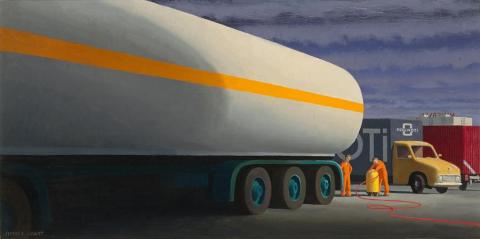THE LARGE TANKER, 1984
JEFFREY SMART
oil on canvas
40.5 x 80.0 cm
signed lower left: Jeffrey Smart
Private collection, Sydney
Deutscher~Menzies, Sydney, 5 March 2002, lot 21
Private collection, Sydney
Jeffrey Smart: Recent Paintings, Rex Irwin Art Dealer, Sydney, 6-24 November 1984, cat. 16
Lynn, E., 'Rich content, but what does it mean?', The Weekend Australian, 17-18 November 1984, p. 16
Smith, M., 'Moved by man's violent environment', The Bulletin, 27 November 1984, pp. 88-89
McDonald, J., Jeffrey Smart: Paintings of the '70s and '80s, Craftsman House, Sydney, 1990, cat. 276, p. 161
Art and Australia, vol. 22, no. 4, Winter 1985, p. 455 (illus.)
Looking at many a Jeffrey Smart painting is like being in the theatre. Lights are low. The curtain is about to rise, and the expectancy is palpable. So it is with The Large Tanker, 1984, the eloquence of its lights and shadows in harmony with the balanced realisation of the forms and captivating colours. The stillness is engrossing, the moment frozen in a kind of eternity of timelessness. So translates Smart the ordinariness of the everyday into something special, spectacular, striking.
When Smart visited Australia in November 1984 for his exhibition at Rex Irwin's gallery in Sydney, The Large Tanker, 1984 was among the works on show. Significantly, this was followed by a talk on Piero della Francesca, Smart's favourite Renaissance artist, given at the Art Gallery of New South Wales. For Smart, Piero was the master of a noble simplicity and monumental grandeur, his ordered compositions also imbued with a stillness tangible. Smart loved him. His influences generously flowed over into Smart's classicism, qualities which we admire so much today in his presentation of the modern world of apartments, roads, signs and overpasses, peopled with trucks, tankers, and their attendant humans. Through the illusion of his brush, the familiar is exposed with the impact of the new, sharpened by concern about our de-humanized world. As Smart once said, 'Man has made prisons for himself in every city; and for the ordinary person escape is very difficult.1 At the same time he was quoted as saying 'The subject-matter is only the hinge that opens the door, the hook on which one hangs the coat.2 And finally, Smart's credo - 'My pictures are synthetic, in that I move things around relentlessly, change the heights of buildings, the colours, to get the composition right.3 The Large Tanker is a triumphant expression of all three. And what could be more telling than its compositional balance? The eye is led by the singularity of the bright yellow container on wheels with its orange hose, its colour alone balancing the grey-white mass of the container like a David and Goliath. Uneasy in its heroic achievement, disorientation is hinted at through the interplay of balance and imbalance. Then, Smart heightens the sense of drama by casting the shadow across the tanker, echoed in the overcast sky, and extended by the eerie light spotlighting the figures. Smart's immaculate essays in the mastery of composition have an enigmatic side. He was a ceaseless traveller and his paintings are full of images of movement - motor vehicles, autostrada and the like. Yet, paradoxically, he realized them as images of stillness in a world embraced by movement.
1. Jeffrey Smart, quoted in McGrath, S., 'Jeffrey Smart', Art and Australia, vol. 7, no. 1, June 1969, p. 36
2. ibid., p. 34
3. Jeffrey Smart quoted in Capon, E., and Greer, G., Jeffrey Smart: Drawings and Studies 1942-2001, Australian Galleries, Sydney, 2001, p. 148
DAVID THOMAS
